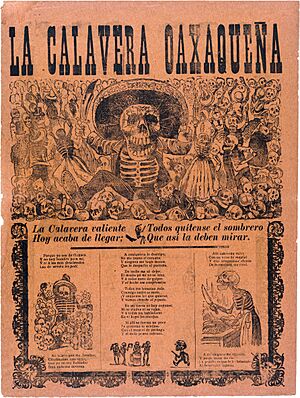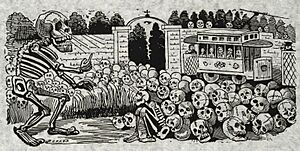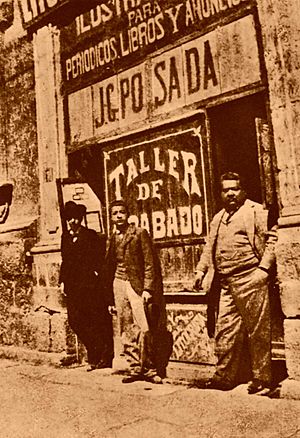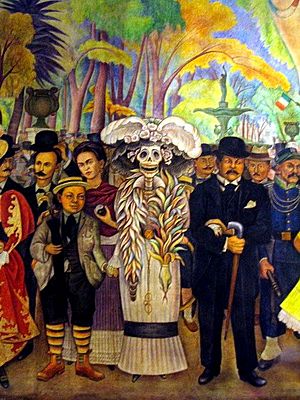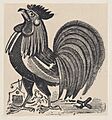José Guadalupe Posada facts for kids
Quick facts for kids
José Guadalupe Posada
|
|
|---|---|
| Born | 2 February 1852 Aguascalientes City, Mexico
|
| Died | 20 January 1913 (aged 60) |
| Occupation | Lithographer |
| Known for | Calaveras |
| Spouse(s) |
María de Jesús Vela
(m. 1875) |
José Guadalupe Posada Aguilar was a famous Mexican artist. He lived from 1852 to 1913. Posada was known for making prints, especially using a method called relief printing. His art often showed funny or critical views of society and politics. He used images of skulls, called calaveras, and bones in his work. Many artists in Latin America were inspired by him. One of his most famous artworks is La Calavera Catrina.
Contents
Early Life and Learning to Draw
José Guadalupe Posada was born in Aguascalientes, Mexico. This was on February 2, 1852. His parents were Germán Posada Serna and Petra Aguilar Portillo. José was one of eight children in his family.
He learned to read, write, and draw from his older brother, Cirilo. Cirilo was a country school teacher. Later, José went to the Municipal Drawing Academy of Aguascalientes. In 1868, when he was a teenager, he started working for Jose Trinidad Pedroza. There, he learned how to make prints using lithography and engraving.
Starting His Art Career
In 1871, Posada began his career as an artist. He became a political cartoonist for a local newspaper. It was called El Jicote, which means "The Bumblebee." His first cartoons were printed there. The newspaper stopped after only 11 issues. This happened because one of Posada's cartoons reportedly upset a powerful local politician.
In 1872, Posada and Pedroza moved to León, Guanajuato. They focused on making commercial prints. In León, Posada opened his own art workshop. He also taught lithography at a local high school. He kept making prints using lithography and wood engraving. In 1873, he went back to his hometown. He married María de Jesús Vela in 1875. The next year, he bought the printing press from Pedroza.
From 1875 to 1888, Posada worked with several newspapers in León. These included La Gacetilla and el Pueblo Caótico. He lived through a big flood in León in 1888. He made several prints showing the sad event. More than 250 bodies were found, and many people went missing.
In late 1888, he moved to Mexico City. There, he learned new ways to engrave using lead and zinc. He worked with newspapers like La Patria Ilustrada. He also worked for the Revisita de Mexico until 1890.
Becoming a Famous Artist
Posada started working with Antonio Vanegas Arroyo. Soon, he opened his own printmaking workshop. His art became very popular. People loved his sense of humor and the quality of his work.
Posada's art showed many things. He showed people's beliefs and daily life. He also showed problems like government unfairness. He illustrated famous skulls and other pictures. These became popular as they were printed in many newspapers.
In 1883, he was hired to teach lithography at a local school. His workshop did well until 1888. That year, a terrible flood hit the city. After the flood, he moved to Mexico City. His first job there was with La Patria Ilustrada. The editor was Ireneo Paz. Posada later joined a publishing company owned by Antonio Vanegas Arroyo. He made many book covers and illustrations there. A lot of his work was also printed on posters. These posters showed exciting news events.
From 1910, when the Mexican Revolution started, until his death in 1913, Posada worked very hard. The art he made during this time helped him become an even better artist. He kept making funny pictures and cartoons for El Jicote magazine. He played an important role for the government. This was during the time of President Francisco I Madero and the campaign of Emiliano Zapata.
Most Famous Artworks
Posada's most well-known artworks are his calaveras. These are images of skulls or skeletons. His most famous work is La Calavera Catrina. This artwork was first printed after he died, in 1913.
Catrina was probably a funny picture of rich Mexicans. They were trying to copy European fashion. But the words that went with the picture, which Posada did not write, made fun of poor street vendors. Posada's Catrina image appeared in other posters too. The famous muralist Diego Rivera later drew Catrina as a full figure. Today, Catrina is the most common image connected to Day of the Dead.
Later Life and Passing
José Guadalupe Posada was mostly forgotten by the end of his life. He passed away in 1913 from a stomach illness. Three of his neighbors confirmed his death. Only one of them knew his full name. He reportedly died without any money. He was buried in a simple, unmarked grave for poor people.
His Lasting Impact

Experts believe Posada made over 20,000 images during his long career. These were for posters, small books, and pamphlets. Important Mexican artists studied Posada's work. These included Jean Charlot, Diego Rivera, and José Clemente Orozco. They helped create a national art style for Mexico. Rivera wrongly believed that Posada was an early revolutionary artist.
Posada is often seen as an artist who used old printing methods. However, he likely used newer photo methods too. He sometimes made his images look old or worn. This was to appeal to his everyday customers. Frida Kahlo spoke highly of Posada. She even put some of his prints in her hotel room in New York City in 1933.
In the 1920s, Jean Charlot, a French-born Mexican artist, helped make Posada's posters famous as art. In 1929, Anita Brenner's book Idols Behind Altars used Posada's pictures. Brenner called Posada a prophet. She connected him to Mexican people, farmers, and workers. The American author Frances Toor also promoted Posada's art. Her 1930 book Posada: Grabador Mexicano was the first book just about Posada. Rivera wrote about 406 of Posada's prints in the introduction to this book.
When Leopoldo Méndez returned from his work in Jalisco, he learned about Posada's prints. Méndez saw Posada as an artistic and cultural hero. One of Méndez's last projects was a study of Posada. In it, Méndez copied over 900 of Posada's illustrations.
Images for kids
See also
 In Spanish: José Guadalupe Posada para niños
In Spanish: José Guadalupe Posada para niños
- Nota roja


